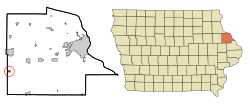Worthington, Iowa facts for kids
Quick facts for kids
Worthington, Iowa
|
|
|---|---|

Location of Worthington, Iowa
|
|
| Country | |
| State | |
| County | Dubuque |
| Area | |
| • Total | 0.45 sq mi (1.17 km2) |
| • Land | 0.45 sq mi (1.17 km2) |
| • Water | 0.00 sq mi (0.00 km2) |
| Elevation | 919 ft (280 m) |
| Population
(2020)
|
|
| • Total | 382 |
| • Density | 845.13/sq mi (326.22/km2) |
| Time zone | UTC-6 (Central (CST)) |
| • Summer (DST) | UTC-5 (CDT) |
| ZIP code |
52078
|
| Area code(s) | 563 |
| FIPS code | 19-87060 |
| GNIS feature ID | 0463210 |
Worthington is a small city in Dubuque County, Iowa, in the United States. In 2020, about 382 people lived there. This was just one more person than in 2000!
Worthington is located along Iowa Highway 136. You can find it north of Cascade and south of Dyersville.
Contents
History of Worthington
The land where Worthington is today was first bought by David Lovelace from the U.S. Government. Later, a railroad company called the Dubuque South-Western Railroad planned to build a train line. This line would connect Farley to Cedar Rapids, Iowa.
How Worthington Started
In 1858, a man from England named Amos Worthington came to the area. He opened a general store. By November of that year, the area became known as the village of Worthington. It was not yet an official town.
Train service started regularly in May 1859. A map of Worthington, called a "plat," was officially recorded in Dubuque County in 1858.
Early Businesses and Churches
In 1861, Amos Worthington sold his store to William Moore. Worthington then moved to Cincinnati, Ohio. This store later became known as the Heffner and Lattner Store. More people began to move to the area and start businesses.
A Baptist church was soon built in Worthington. James Hill was its first Pastor. In 1868, Father Kortenkamp from a church in Dyersville decided Worthington needed its own Catholic church. That's when St. Paul's Catholic Church began.
Becoming an Official City
On October 1, 1892, some local citizens asked the court to make Worthington an official town. On November 23, the court chose five people to be "commissioners." These people were Peter Baum, W. Lattner, G.A. Dando, Louis Hoppleu, and Theodore Ament.
Their job was to arrange a special election. All qualified people in the area could vote on whether Worthington should become an official town. This election happened on January 2, 1893. There were 42 votes. Thirty-two people voted yes, and ten voted no.
The court clerk announced the election results on January 10, 1893. The news about the election was also printed in the Dyersville Commercial newspaper. On March 6, 1893, the court officially confirmed the election results. Worthington, Iowa, officially became an incorporated city on January 10, 1893.
Worthington's Geography
Worthington is located at 42°23′48″N 91°7′10″W / 42.39667°N 91.11944°W. This is its exact spot on a map.
The city covers a total area of about 0.39 square miles (1.01 square kilometers). All of this area is land, with no water.
Population and People
| Historical populations | ||
|---|---|---|
| Year | Pop. | ±% |
| 1880 | 169 | — |
| 1900 | 288 | +70.4% |
| 1910 | 314 | +9.0% |
| 1920 | 341 | +8.6% |
| 1930 | 335 | −1.8% |
| 1940 | 326 | −2.7% |
| 1950 | 337 | +3.4% |
| 1960 | 360 | +6.8% |
| 1970 | 365 | +1.4% |
| 1980 | 432 | +18.4% |
| 1990 | 439 | +1.6% |
| 2000 | 381 | −13.2% |
| 2010 | 401 | +5.2% |
| 2020 | 382 | −4.7% |
| Source: and Iowa Data Center Source: |
||
Worthington in 2020
In 2020, the census counted 382 people living in Worthington. There were 153 households and 93 families. Most people living in the city were White (99.2%).
About 24.8% of households had children under 18 living with them. The average age of people in Worthington was 39.1 years. About 24.1% of residents were under 20 years old. Also, 19.6% were 65 years or older. The city had slightly more males (52.9%) than females (47.1%).
Worthington in 2010
In 2010, the census showed 401 people lived in Worthington. There were 160 households and 109 families. Most people were White (98.5%).
About 31.9% of households had children under 18. The average age was 38.9 years. About 26.4% of residents were under 18. And 13% were 65 or older. The city had slightly more males (50.6%) than females (49.4%).
Education in Worthington
Worthington is part of the Western Dubuque Community School District. Students living in Worthington go to Dyersville Elementary School in Dyersville. They then attend Drexler Middle School in Farley. For high school, they go to Western Dubuque High School in Epworth.
There was also a Catholic school called St. Paul School. It started around 1874. In 2015, it had 26 students, but it closed that same year.
Famous People and Mentions
- Matt Tobin, an American football player, grew up in Worthington. He played as an offensive tackle for the New England Patriots.
- Worthington is mentioned in the 2011 book Ashfall by Mike Mullin. It is one of the places the main character visits on their journey.
See also
 In Spanish: Worthington (Iowa) para niños
In Spanish: Worthington (Iowa) para niños

